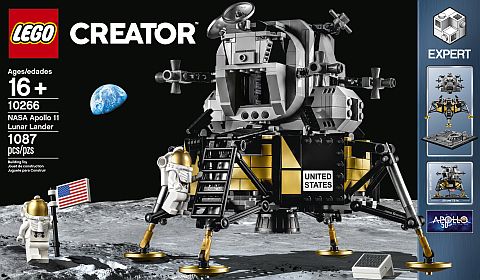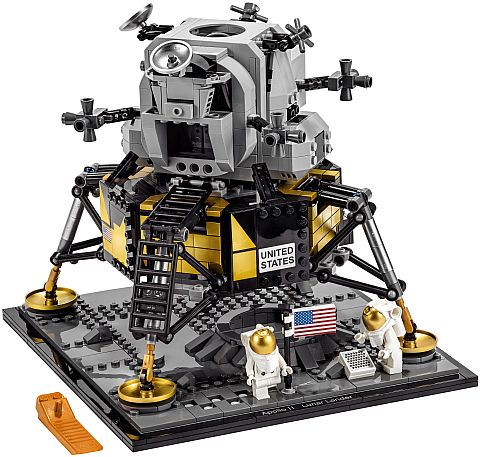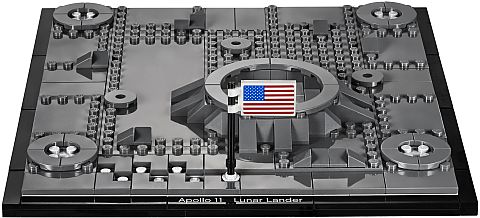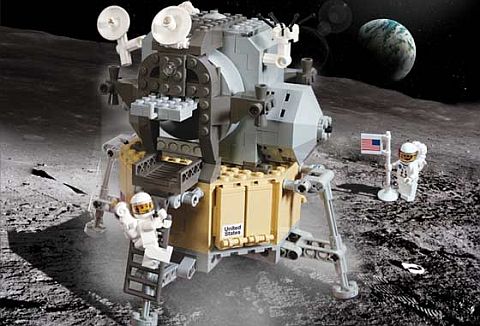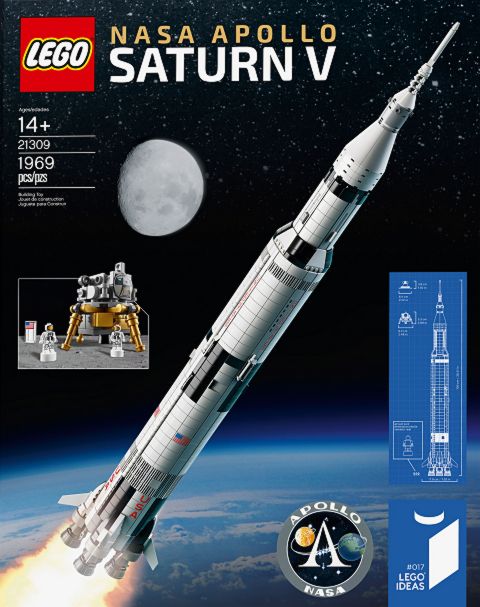(Written by William)
If you would like to get specific characters from the new #71024 LEGO Collectible Minifigures Series 2 Disney blind bags, you will have to learn how to feel for them with your fingers through the bags. We have discussed and reviewed the eighteen minifigures in the series already (see: LEGO Collectible Minifigures Series 2 Disney), and today we will talk about how to identify them easily.

The series includes characters from eight major themes, mostly put in pairs; Vintage Disney (2 minifigs), Ducktales (4 minifigs), Chip ‘N’ Dale (2 minifigs), Frozen (2 minifigs), Aladdin (2 minifigs), Hercules (2 minifigs), The Nightmare Before Christmas (2 minifigs), and The Incredibles (2 minifigs). Unfortunately, although a full box of 60 minifigs should be able to accommodate three full collections (plus six extra minifigs), the distribution of the minifigs is not even, so you will only be able to get two full collections and a bunch of extra minifigs.
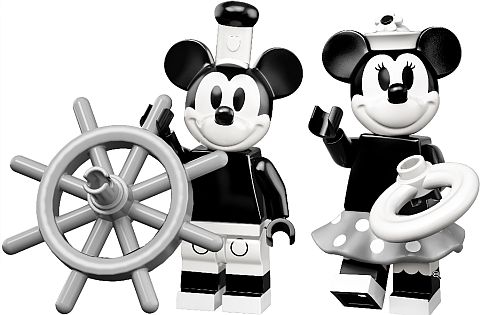
➡ LEGO DISNEY MINIFIGS – VINTAGE MICKEY: Feel for Mickey’s head. It’s one of the most distinct shapes LEGO has done for minifigures. Once you got that, verify it is not Minnie by locating the ship wheel. This is the traditional ship wheel that LEGO released in the past, so it will have a pin connector on one side in the middle. There should be four Mickey minifigs in a full box.
➡ LEGO DISNEY MINIFIGS – VINTAGE MINNIE: Like Mickey, start with feeling for the mouse head. Once you got that, look for the skirt. It’s hard plastic and kind of feels like a slightly squashed cupcake wrapper. If you happen to locate it first, the life preserver works just as well being a plain round hoop. There should be four Minnie minifigs in a full box.
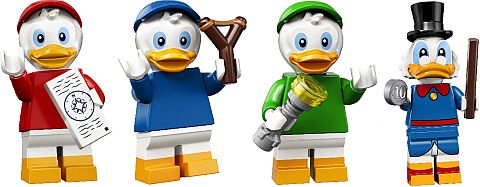
➡ LEGO DISNEY MINIFIGS – HUEY: There are three ducklings in this series, only distinguished by their colors and accessories. The red duckling, Huey comes with a book made up of three parts. I like finding the bottom of the book since it has a fairly distinct edge. But I can imagine finding the book cover is equally easy since it kind of feels like a flat square flag piece. If you run across a 1×2 tile first, it could also be Edna, so it’s not the best piece to rely on. Only two Huey minifigs in a full box, so this character is very rare.
➡ LEGO DISNEY MINIFIGS – DEWEY: The blue duckling only has one accessory; a slingshot. This piece hasn’t appeared in very many sets yet, so you may not be familiar with it. It feels a lot like the standard carrot top piece with a stem and two flared out little leaves. Only two Dewey minifigs in a full box, so this character is very rare.
➡ LEGO DISNEY MINIFIGS – LOUIE: The green duckling can be easily identified by the lightsaber hilt. If you want to be doubly sure, find the 1×1 round tiles that make up the lens of his flashlight. (There is an extra lightsaber hilt and an extra round tile per pack, so don’t be confused when you find two of each). Only two Louie minifigs in a full box, so this character is very rare.
➡ LEGO DISNEY MINIFIGS – SCROOGE MCDUCK: Look for the top hat, but make sure it’s not Classic Mickey’s hat. It’s like a smaller version of Penguin’s stovepipe hat from the LEGO Batman sets. The short bar (there is an extra included) are also good indicators as non of the other characters come with a simple bar piece. You can find four of this character in a full box.
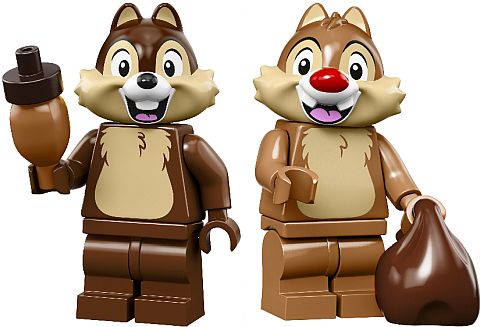
➡ LEGO DISNEY MINIFIGS – CHIP: Chip and Dale are identical, but their accessories are different. In the case of Chip, chances are you’ll find the 1×1 modified round tile, but this is very hard to distinguish from the standard 1×1 round tiles unless you have very sensitive fingers. I would suggest to look for the rounded nut instead. It feels a lot like a fat carrot. If you find something and think turnip, it’s probably the right part. This is another common minifig with four in a full box.
➡ LEGO DISNEY MINIFIGS – DALE: Dale got only one accessory; a sack. The issue is that the sack feels very much like a chipmunk head. So, to tell Dale apart from Chip, find two oddly round parts and no other accessories. If it feels like you’re holding two special molded heads at the same time, you have Dale’s head and his sack. This is another common minifig with four in a full box.
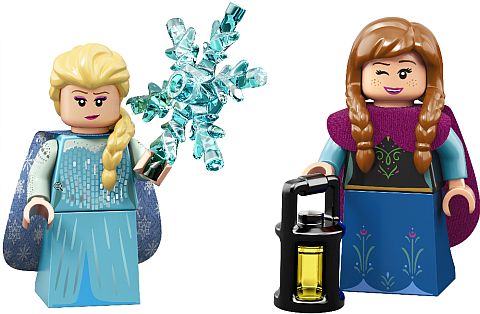
➡ LEGO DISNEY MINIFIGS – ELSA: Start by finding the dress slope. It’s the newer version with a curved back slope. Then, look for the big snowflake. It’s hard to miss. This is another common minifig with four in a full box.
➡ LEGO DISNEY MINIFIGS – ANNA: Here, again, I recommend looking for the dress slope first, but since two other figures have a dress slope in this series (Elsa and Jafar), confirm her identify by looking for the 1×1 round brick that makes up the lamp. This is another common minifig with four in a full box.
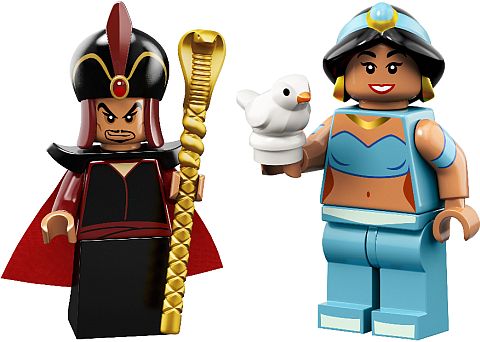
➡ LEGO DISNEY MINIFIGS – JAFAR: This is the third minifig in this series with a dress slope, so you may find that first. Then, you can look for the snake staff, which is the longest piece in this series and thus easy to identify. Or, you can just go for the snake staff first. There are three Jafar minifigs in a full box.
➡ LEGO DISNEY MINIFIGS – JASMINE: This minifig is a bit tricky to identify. Typically, I found her hairpiece with long braid at the back first. If I thought that’s what I had, then I went for the bird. It feels pretty close to the chicken found in other sets, just a bit smaller. There are three Jasmine minifigs in a full box.

➡ LEGO DISNEY MINIFIGS – HADES: This minifig comes with the largest moulded part in the series. The tentacles are enormous, So, if you find a big hunk of plastic that seems like it has minifigure leg studs at the top, then you got this villain. This is another common minifig with four in a full box.
➡ LEGO DISNEY MINIFIGS – HERCULES: It’s all about the swords and shield with this guy. If you got either of those, you’re good. This minifig could be a great army-builder, but unfortunately there are only three in a full box.
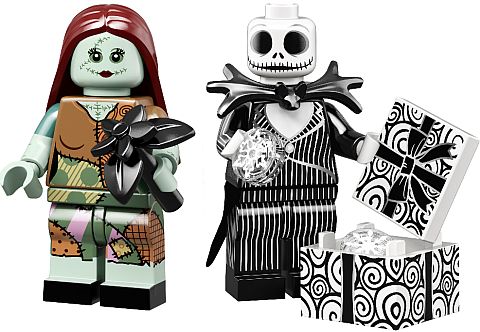
➡ LEGO DISNEY MINIFIGS – SALLY: If you got the Giraffe Guy from the LEGO Movie 2 Collectible Minifigure Series then you know what the plant she has feels like. If you don’t, then try to find a part that feels like a grappling hook. I also double check by finding her long hair. The hair is pretty flat and I’ve heard it described as feeling like a flipper. You can find three of this minifig in a full box.
➡ LEGO DISNEY MINIFIGS – JACK SKELLINGTON: The 2×2 box is really hard to miss. Find it and you got Jack… Skellington that is. If you need an alternate piece, the 2×2 tile is also great as no other minifig has that piece. You can find three of this minifig in a full box.

➡ LEGO DISNEY MINIFIGS – EDNA: I’d recommend finding the modified 1×2 plate with bar off the long edge. It’s a pretty recognizable part. However, just to make sure it’s not confused with the book bottom that Huey has, try finding her basic minifigure head or her tea cup. You can find three of this minifig in a full box.
➡ LEGO DISNEY MINIFIGS – FROZONE: If you don’t want to miss this guy, go for the large 4×4 round modified tile/plate. It’s like a second minifigure stand but round. This is another common minifig with four in a full box.
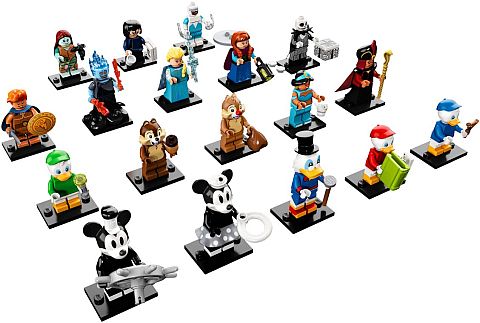
The Series 2 Disney Minifigures are available from LEGO retailers, official LEGO stores, and the Online LEGO Shop. If you have trouble finding the series at regular retailers in your area, check Game Stop. If you visit their website and select to pick up items in store, the system will tell you which Game Stop stores in your area carry the Disney minifigs. Not all of their stores carry them, so this is a quick way to check inventory before you visit the shop.
If you decide to make a purchase at the Online LEGO Shop, keep in mind that there is a limit of 18 mystery bags per household. However, this does not guarantee that you will get a full collection of the 18 different characters. You may get two or more of some and miss some completely. For more details, visit the minifigures section of the Online LEGO Shop.

What do you think? How do you like the second series of LEGO Collectible Disney Minifigures? Are you planning to collect them all? Do you have some of them already? Which ones are your favorite characters? Feel free to share and discuss in the comment section below!
And you might also like to check out the following related posts:
